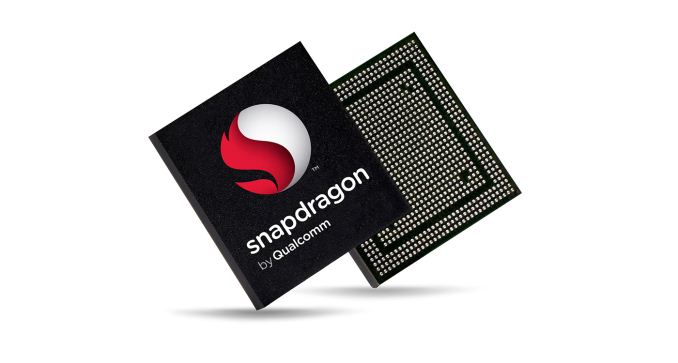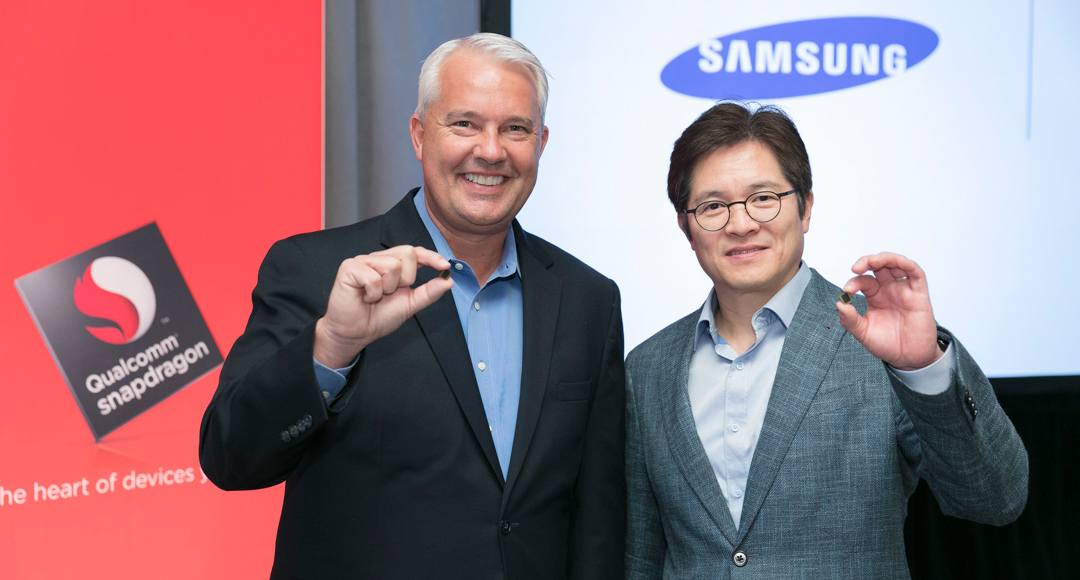Qualcomm Announces Next-Generation Snapdragon 835 SoC Using Samsung’s 10nm Node
by Matt Humrick on November 17, 2016 7:30 AM EST- Posted in
- Smartphones
- Samsung
- Snapdragon
- Qualcomm
- Mobile
- Snapdragon 835

Qualcomm revealed the name of its newest SoC, the Snapdragon 835, at its Snapdragon Technology Summit in New York today. The new SoC replaces the Snapdragon 820/821 at the top of its lineup. While Qualcomm is not yet ready to disclose the specifics about what’s inside the Snapdragon 835, it did confirm one important detail.

Keith Kressin (left) and Ben Suh (right) holding Snapdragon 835, the first 10nm SoC
Keith Kressin, Senior Vice President of Product Management at Qualcomm, took the stage with Ben Suh, Senior Vice President of Foundry Marketing at Samsung Systems-LSI, to announce that the Snapdragon 835 will use Samsung’s 10nm "10LPE" FinFET manufacturing node. We do not know the Snapdragon 835’s power or performance numbers yet, but according to Samsung its 10nm process “allows up to a 30% increase in area efficiency with 27% higher performance or up to 40% lower power consumption.” The switch from 14nm to 10nm, along with other changes, give the Snapdragon 835 a smaller die size than the Snapdragon 820 SoC, and should also help improve battery life.
The Snapdragon 835 is already in mass production and on schedule to appear in commercial devices during the first half of 2017.










65 Comments
View All Comments
tuxRoller - Thursday, November 17, 2016 - link
They don't need to differentiate with the cpus, however. They've got a very good gpu (though it appears their video decoders could use some work), excellent dsps, a very, very good audio codec and amp combo (I believe it's called aqstic), a class leading dsp (with good tooling), and the best modems.That's ALL value added hardware that only they can provide. Dropping the best-in-androidland arm ref cores into their designs (not as easy as that, obviously, but far cheaper than designing your own and, given their track record, it seems like it would behoove them to consider not always going with their own designs) would be pretty awesome, I believe.
BurntMyBacon - Friday, November 18, 2016 - link
@tuxRoller: "They've got a very good gpu (though it appears their video decoders could use some work), excellent dsps, a very, very good audio codec and amp combo (I believe it's called aqstic), a class leading dsp (with good tooling), and the best modems."Agreed on all points here. It's amazing that Qualcomm gets so many design wins, yet so many people miss so much of the value equation.
@tuxRoller: "Dropping the best-in-androidland arm ref cores into their designs (not as easy as that, obviously, but far cheaper than designing your own and, given their track record, it seems like it would behoove them to consider not always going with their own designs) would be pretty awesome, I believe."
I have some experience in designing silicon chips, though I'm nowhere near the expert companies like Qualcomm employ. In my mind, the verdict is still out on who has the "best-in-androidland" cores (more on that in a minute). You are correct, it isn't as easy as it sounds to just drop in a ref core. You are also correct that it is still cheaper than designing your own in-house. However, benefits of designing your own go beyond just CPU performance or efficiency. Maintaining control over the design allows for many integration benefits. All the value adds you mention above have to connect somehow and maintaining more control over the core can provide latency, efficiency, and/or even thermal distribution benefits. Contrary to your statement, I do believe that they are in fact constantly considering the reference core designs. The Cortex A7, A53, and A72 are currently in heavy use in the 200, 400/600, and 600 series designs respectively.
https://en.wikipedia.org/wiki/List_of_Qualcomm_Sna...
It is in fact their given track record (Think 808/810) that keeps them designing their own cores for their most premium devices. Given the drawbacks they had with A57 that neither they (with their own Krait designs) nor other manufacturers were experiencing, it is not hard to imagine that the problem lies outside of the core itself. This remained true even after revisions were made to the designs, so I can't just write it off as the result of a rushed design. I suspect that they had trouble with the integration of the cores with their IP, rather than the core itself. In other words, it is quite possible that, paired with a lesser (or at least different) set of IP and optimized for such integration, the Kryo design could be higher performing or more efficient than the reference counterparts. In the end, we can't really know, but we can be sure that Qualcomm sees some value in continuing to design their own cores and I am perfectly willing to trade off a little performance for some of the value adds you mention above.
rocketbuddha - Saturday, November 19, 2016 - link
I think the 810 had the worst of 2 worldsCortex A57 is a not as good as they expected. So ARM hurried up got A72 to replace it. But A53 still remains the little core for gens of big core.
TSMC 20nm process was also problematic. SMSG made its A57 in its 14nm FinFET and was able to better QCOM. Also I remember this graphic from Andrei here
http://images.anandtech.com/doci/9762/P1030606.jpg...
142.5% power over a unit area.
tuxRoller - Thursday, November 24, 2016 - link
Crap! Sorry, I didn't see this response.I'm glad you pointed out their use of the ref cores, but, I've one thing to add: excepting their Wear line of socs, and assuming they have a competing custom core, they tend to gimp the ref arm cores in some way (process node, frequency, gpu).
With regards to 808/810, I don't think they did that bad of a job relative to the competition (additionally, their kryo core, even with a freq advantage, doesn't always outperform the a57s... something Samsung doesn't seem to have to worry about with their m1). Their 808, in particular, was quite respectable, and had it been clocked higher, and given the adreno 430, they would've had a rather nice design. In fact, iirc, arm suggested that the the a57 be paired with the a53 in a 1:2 ratio.
However, that's besides the point. Qualcomm has shown, as you pointed out, that it has proficiency with integrating arm ref cores with their own ip. Now, unless we are to assume there is something special about their high-end socs (aside from component performance) that makes integration particularly difficult I'd assume that the previous generation was due to relatively poor integration (recall, the first exynos that used the a57 had pretty serious issues, as reported by this site).
rocketbuddha - Saturday, November 19, 2016 - link
QCOM has to justify its cores as they are ISA implementor and it takes more time to produce one but the advantages of a good design will give it a leg up competiton. When I looked at some investor presentations of QCOM long back before they became a top-dog, they would constantly justify as to why they went with the custom ARM model. So if the 835 was a custom core, I expect them to definitely boasting it as it is another justification to their Investors and Shareholders.Even in the current set of products except for the top dog 820 everything else seems to be standard ARM core..... I have not seen anyother time that their custom core justification is more wanting.
tuxRoller - Thursday, November 24, 2016 - link
The thing is (iirc), their cores, going back to the first snapdragon, usually have lower IPC. To be competitive, they had to clock them higher, but even then they tended to be running against the wind when it comes to efficiency.I need to pull up some of those old reviews to verify this thought...
systemBuilder - Friday, November 25, 2016 - link
Qualcomm makes their own ARM cores but they don't really give a shit about whether they work or benchmark too well. The company is run by-and-for the enjoyment of the wireless systems engineers. CPU design is just a sideshow for them.tuxRoller - Friday, November 25, 2016 - link
Um...sure thing;)That obviously explains why all of the other arm isa licensees have been producing much better designs over the years...
ARM has tremendously good engineers. As good as exist in the business especially considering their relatively small amount of resources.
They develop entire platforms excluding batteries, screens, modems, camera sensors and touch sensors (all of which have a number of other vendors that will offer you their wares).
tuxRoller - Friday, November 25, 2016 - link
One more thing: if you're only comparing them to Apple you need to realize that they aren't playing in the same box. Apple build massive, expensive cores while arm, thus far, leans towards the best perf they can get for, roughly, a constant purchasing unit (which things tilted differently depending on the exact core line they are working on).fanofanand - Thursday, November 17, 2016 - link
I have read about an 830 that is supposedly going to be in devices at the end of this year so I think the 835 is just a smaller node version of the 830 though I am just speculating.